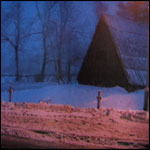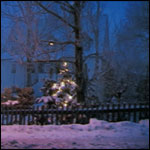Moving Pictures
Galerie Behemot – June 15th – July 7th, 2001
One process that is peculiar to cinema is that of generating the impression of movement. Much like a still camera, a movie camera can only take one picture at a time, and the same is true with a projector, which can only show one frame at a time.
 The film moves intermittently, driven and stopped by the sprockets, which in turn are driven by a crank or a motor. A motor and a camera are also just a few of the components that drove Veronika Drahotova to create her series of photographs exhibited recently in Mind the Heart at Galerie Behemot in Prague.
The film moves intermittently, driven and stopped by the sprockets, which in turn are driven by a crank or a motor. A motor and a camera are also just a few of the components that drove Veronika Drahotova to create her series of photographs exhibited recently in Mind the Heart at Galerie Behemot in Prague.
“The motion picture can be thought of as any image that has been given the illusory property of movement.”(Bruce F. Kawin, How Movies Work (1987), 41-43.) Watching a film involves making connections among fragments or frames while putting together a holistic impression.
 In her series of images entitled Veron (Farewell my Concubine), Veronika has created a film-like succession of photographic self-portraits, in which she is the main subject of the viewer’s gaze. Acting within her own mise-en-scene(set in a bedroom), she’s all dressed-up with nowhere to go, pouting and puckering in front of the camera, not unlike a prostitute before a customer, or an actress practicing in front of a mirror.
In her series of images entitled Veron (Farewell my Concubine), Veronika has created a film-like succession of photographic self-portraits, in which she is the main subject of the viewer’s gaze. Acting within her own mise-en-scene(set in a bedroom), she’s all dressed-up with nowhere to go, pouting and puckering in front of the camera, not unlike a prostitute before a customer, or an actress practicing in front of a mirror.
Certain props have been appropriately placed in and out of frame with reference back to the actual film from which she took the title, emphasizing the fantasy of Veronika (or any woman) as concubine, as living an “amoral” life.
Overly made-up, posing and coquettishly smirking for the camera in her asian-style dress, there is a sense of fluid movement to her actions.
And while the images are not placed in an authentic motion sequence, they fragmentally stand as still frames from a filmic whole. We can envision “Veron” tossing her hair, moving into a closeup, and going from expressions of smiles to states of disgust.
Her use of the masculine nick-name “Veron” again makes reference back to the original film, causing a break in the viewer’s concupiscent objectification of this woman, since it could in fact (assuming the viewer doesn‘t know what the artist looks like) be a man in drag.
Veronika‘s second series of images entitled Lenscape (Borderline) lined the opposite wall of Galerie Behemot almost in mirror-style reflection to the series Veron. Deeply soft-coloured images of winter-laden houses on a early winter evening offer touches of sentimentality and sordid fantasies.
All the images are a bit off center or a little out of frame, and, when placed side-by-side, quickly become more like a flowing film strip than still photography. Then there‘s the discovery that these fragile images were probably taken in passing along the Czech border, prohibiting the viewer the time to get lost in the seductive scene.
The artist turns our head away suddenly, forbidding prolonged imaginings of oneself walking up that snow-covered path and into that warmly lit home where who knows what awaits. There is a sense of danger among these family-styled homes and picket fences.
The Czech-German border is a place notoriously known for its thriving prostitution business. All kinds of women stand just off the highway, in front of houses or shops, supposedly offering fantasy for the asking.
Drahotova’s images alsooffer fantasy, but only in addition to a dose of reality along with it. There is frustration, pleasure, disappointment, and recurrence found all at once in this detached nomadic non-narrative.
And there is also a kind of endless rotation as well, a dizzyness as the viewer passes by these private houses, stops at a light and peers inside, but then turns away and moves on, back to the long dark highway.
“The retina retains a brief afterimage of each picture still, so that each frame makes a particularly distinct impression.(Bruce F. Kawin, How Movies Work (1987), 41-43.)” The “persistence of vision” accounts for our not being aware of the darkness between frames, because the retina continues to “see” the image even when the screen has gone dark.
Just as when Picasso drew an image in the air using a glowing ember and the image somehow magically remained for a few seconds afterwards although it had, in fact, already disappeared.
While the single gloomy image of the Gothic church found in the Lenscape series is disruptive and becomes too much of a moralistic reminder, the actual image itself is so hauntingly beautiful that it also keeps magically coming back into mind, even though it is no longer actually there.




